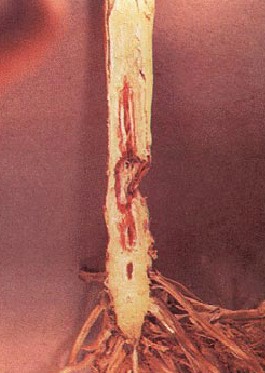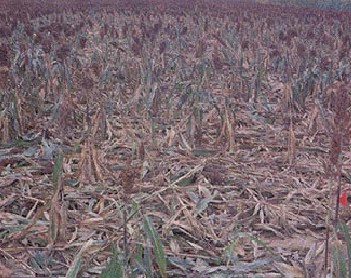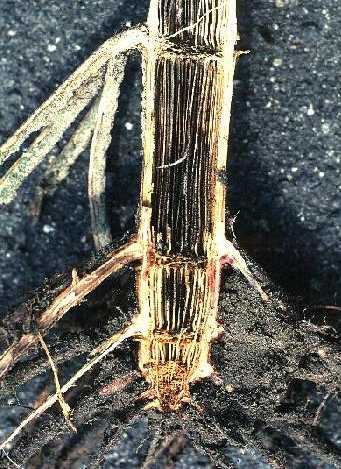Stalk Rots of Sorghum
 Causal Agent
Causal Agent
Fusarium stalk rot is caused by the fungus Fusarium moniliforme; Charcoal stalk rot is caused by the fungus Macrophomina phaseolina
Hosts
Sorghum
Symptoms

Root and lower stalk interior symptoms - If a stalk rot problem is suspected from observing the above described symptoms, the following procedure will provide a positive diagnosis. Dig several of the suspected plants and wash or shake the soil from the root system. Then split the stalks lengthwise through the crown area. Next, examine the interior of the lower stalk, crown and roots. The most characteristic symptom of sorghum stalk rots is the shredding of the internal tissue of the lower internodes. This shredded tissue may be pink or reddish-brown indicating Fusarium stalk rot or grayish-brown indicating charcoal rot. An easily seen and very diagnostic feature of charcoal rot is the black fungal resting bodies, called sclerotia, which adhere to vascular strands, giving the stalk interior a charred appearance. Ultimately, the decay of interior stalk tissue results in stalk lodging.
Control

- Select hybrids whose past performance has indicated satisfactory stalk length.
- Avoid excessively thick plantings as this will help reduce stressful competition for moisture and nutrients.
- Provide adequate weed control since weeds are major competitors for moisture and nutrients.
- When possible, plant full season hybrids.
- Maintain balanced soil fertility. Avoid the use of excessive amounts of nitrogen.
- Control insects when populations are high enough to stress plants.
- Harvest as soon as possible to prevent excessive losses from lodging.
In summary, any practice which will reduce stress on the plants, particularly during the periods of pollination, grain development and maturation, will also reduce stalk rot problems. Please contact your local county extension office for current information.

